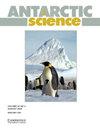Valley-floor snowfall in Taylor Valley, Antarctica, from 1995 to 2017: spring, summer and autumn
IF 2
4区 地球科学
Q3 ENVIRONMENTAL SCIENCES
引用次数: 2
Abstract
Abstract We present an analysis of the 20 year snowfall dataset in Taylor Valley and the results of a new snow cover monitoring study. Snowfall has been measured at four sites in Taylor Valley from 1995 to 2017. We focus on valley-floor snowfall when wind does not exceed 5 m s-1, and we exclude winter from our analysis due to poor data quality. Snowfall averaged 11 mm water equivalent (w.e.) from 1995 to 2017 across all stations and ranged from 1 to 58 mm w.e. Standard deviations ranged from 3 to 17 mm w.e., highlighting the strong interannual variability of snowfall in Taylor Valley. During spring and autumn there is a spatial gradient in snowfall such that the coast received twice as much snowfall as more central and inland stations. We identified a changepoint in 2007 from increasing snowfall (3 mm w.e. yr-1) to decreasing snowfall (1 mm w.e. yr-1), which coincides with a shift from decreasing temperature to no detectable temperature trend. Daily camera imagery from 2007 to 2017 augments the snowfall measurements. The camera imagery revealed a near tripling of the average number of days with snow cover from 37 days between 2006 and 2012 to 106 days with snow cover between 2012 and 2017.1995年至2017年,南极洲泰勒谷的谷底降雪:春季、夏季和秋季
摘要我们对泰勒河谷20年的降雪数据集进行了分析,并给出了一项新的积雪监测研究的结果。从1995年到2017年,泰勒山谷的四个地点都有降雪量。我们关注的是风不超过5米s-1时的谷底降雪,由于数据质量差,我们将冬季排除在分析之外。1995年至2017年,所有站点的平均降雪量为11毫米水当量,范围为1至58毫米水当量。标准偏差为3至17毫米水当量的范围,突出了泰勒谷降雪量的强烈年际变化。在春季和秋季,降雪量存在空间梯度,因此沿海地区的降雪量是中部和内陆地区的两倍。我们在2007年确定了一个变化点,从降雪量增加(每年3毫米)到降雪量减少(每年1毫米),这与从气温下降到没有可检测温度趋势的转变相吻合。2007年至2017年的每日相机图像增强了降雪量的测量。相机图像显示,平均积雪天数从2006年至2012年的37天增加到2012年至2017年的106天,几乎增加了两倍。
本文章由计算机程序翻译,如有差异,请以英文原文为准。
求助全文
约1分钟内获得全文
求助全文
来源期刊

Antarctic Science
地学-地球科学综合
CiteScore
3.60
自引率
6.20%
发文量
42
审稿时长
3 months
期刊介绍:
Antarctic Science provides a truly international forum for the broad spread of studies that increasingly characterise scientific research in the Antarctic. Whilst emphasising interdisciplinary work, the journal publishes papers from environmental management to biodiversity, from volcanoes to icebergs, and from oceanography to the upper atmosphere. No other journal covers such a wide range of Antarctic scientific studies. The journal attracts papers from all countries currently undertaking Antarctic research. It publishes both review and data papers with no limits on length, two-page short notes on technical developments and recent discoveries, and book reviews. These, together with an editorial discussing broader aspects of science, provide a rich and varied mixture of items to interest researchers in all areas of science. There are no page charges, or charges for colour, to authors publishing in the Journal. One issue each year is normally devoted to a specific theme or papers from a major meeting.
 求助内容:
求助内容: 应助结果提醒方式:
应助结果提醒方式:


